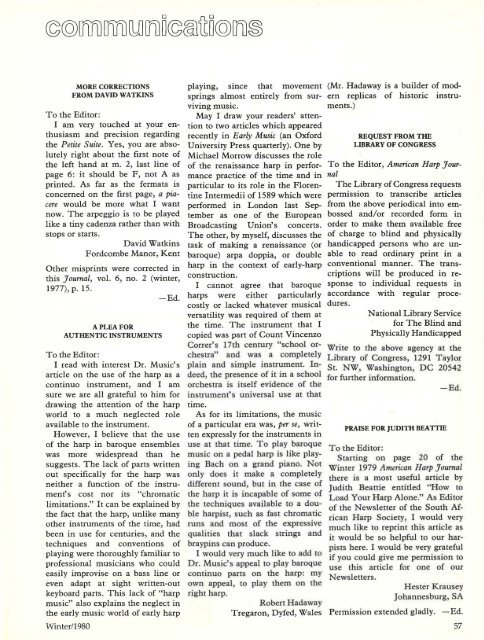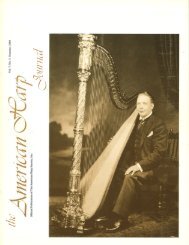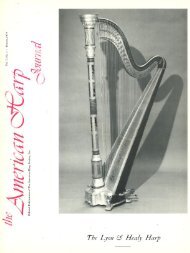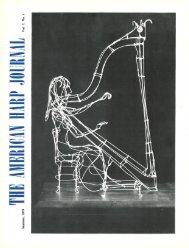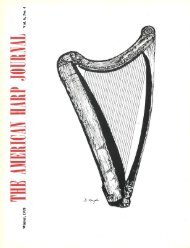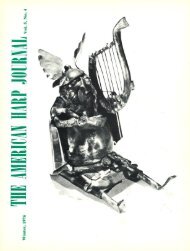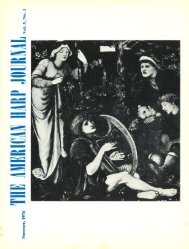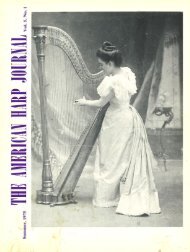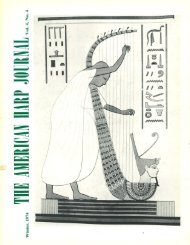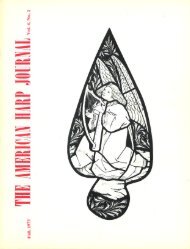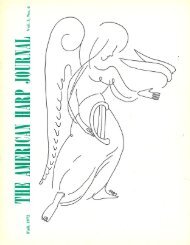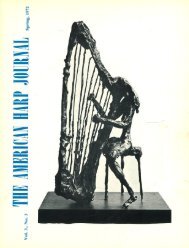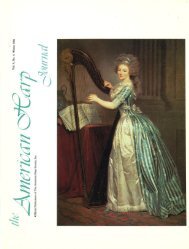Create successful ePaper yourself
Turn your PDF publications into a flip-book with our unique Google optimized e-Paper software.
MORE CORRECTIONS<br />
FROM DAVID WATKINS<br />
To the Editor:<br />
I am very touched at your enthusiasm<br />
and precision regarding<br />
the Petite Suite. Yes, you are absolutely<br />
right about the first note of<br />
the left hand at m. 2, last line of<br />
page 6: it should be F, not A as<br />
printed. As far as the fermata is<br />
concerned on the first page, a piacere<br />
would be more what I want<br />
now. The arpeggio is to be played<br />
like a tiny cadenza rather than with<br />
stops or starts.<br />
David Watkins<br />
Fordcombe Manor, Kent<br />
Other misprints were corrected in<br />
this Journal, vol. 6, no. 2 (winter,<br />
1977), p. 15.<br />
-Ed.<br />
A PLEA FOR<br />
AUTHENTIC INSTRUMENTS<br />
To the Editor:<br />
I read with interest Dr. Music's<br />
article on the use of the harp as a<br />
continuo instrument, and I am<br />
sure we are all grateful to him for<br />
drawing the attention of the harp<br />
world to a much neglected role<br />
available to the instrument.<br />
However, I believe that the use<br />
of the harp in baroque ensembles<br />
was more widespread than he<br />
suggests. The lack of parts written<br />
out specifically for the harp was<br />
neither a function of the instrument's<br />
cost nor its "chromatic<br />
limitations." It can be explained by<br />
the fact that the harp, unlike many<br />
other instruments of the time, had<br />
been in use for centuries, and the<br />
techniques and conventions of<br />
playing were thoroughly familiar to<br />
professional musicians who could<br />
easily improvise on a bass line or<br />
even adapt at sight written-out<br />
keyboard parts. This lack of "harp<br />
music" also explains the neglect in<br />
the early music world of early harp<br />
<strong>Winter</strong>/<strong>1980</strong><br />
playing, since that movement (Mr. Hadaway is a builder of modsprings<br />
almost entirely from sur- em replicas of historic instruviving<br />
music.<br />
ments.)<br />
May I draw your readers' attention<br />
to two articles which appeared<br />
recently in Early Music (an Oxford<br />
REQUEST FROM THE<br />
University Press quarterly). One by LIBRARY OF CONGRESS<br />
Michael Morrow discusses the role<br />
of the renaissance harp in performance<br />
practice of the time and in<br />
particular to its role in the Florentine<br />
Intermedii of 1589 which were<br />
performed in London last September<br />
as one of the European<br />
Broadcasting Union's concerts.<br />
The other, by myself, discusses the<br />
task of making a renaissance (or<br />
baroque) arpa doppia, or double<br />
harp in the context of early-harp<br />
construction.<br />
I cannot agree that baroque<br />
harps were either particularly<br />
costly or lacked whatever musical<br />
versatility was required of them at<br />
the time. The instrument that I<br />
copied was part of Count Vincenzo<br />
Correr' s 17th century "school orchestra"<br />
and was a completely<br />
plain and simple instrument. Indeed,<br />
the presence of it in a school<br />
orchestra is itself evidence of the<br />
instrument's universal use at that<br />
time.<br />
As for its limitations, the music<br />
of a particular era was, per se, written<br />
expressly for the instruments in<br />
use at that time. To play baroque<br />
music on a pedal harp is like playing<br />
Bach on a grand piano. <strong>No</strong>t<br />
only does it make a completely<br />
different sound, but in the case of<br />
the harp it is incapable of some of<br />
the techniques available to a double<br />
harpist, such as fast chromatic<br />
runs and most of the expressive<br />
qualities that slack strings and<br />
braypins can produce.<br />
I would very much like to add to<br />
Dr. Music's appeal to play baroque<br />
continua parts on the harp: my<br />
own appeal, to play them on the<br />
right harp.<br />
Robert Hadaway<br />
To the Editor, American Harp Journal<br />
The Library of Congress requests<br />
permission to transcribe articles<br />
from the above periodical into embossed<br />
and/or recorded form in<br />
order to make them available free<br />
of charge to blind and physically<br />
handicapped persons who are unable<br />
to read ordinary print in a<br />
conventional manner. The transcriptions<br />
will be produced in response<br />
to individual requests in<br />
accordance with regular procedures.<br />
National Library Service<br />
for The Blind and<br />
Physically Handicapped<br />
Write to the above agency at the<br />
Library of Congress, 1291 Taylor<br />
St. NW, Washington, DC 20542<br />
for further information.<br />
-Ed.<br />
PRAISE FOR JUDITH BEATTIE<br />
To the Editor:<br />
Starting on page 20 of the<br />
<strong>Winter</strong> 1979 American Harp Journal<br />
there is a most useful article by<br />
Judith Beattie entitled "How to<br />
Load Your Harp Alone." As Editor<br />
of the Newsletter of the South African<br />
Harp Society, I would very<br />
much like to reprint this article as<br />
it would be so helpful to our harpists<br />
here. I would be very grateful<br />
if you could give me permission to<br />
use this article for one of our<br />
Newsletters.<br />
Hester Krausey<br />
Johannesburg, SA<br />
Tregaron, Dyfed, Wales Permission extended gladly. -Ed.<br />
57


